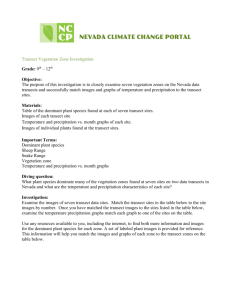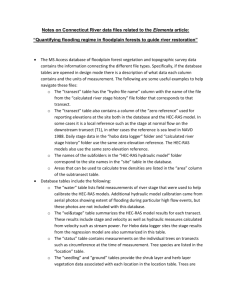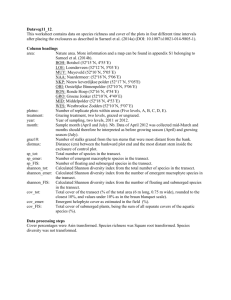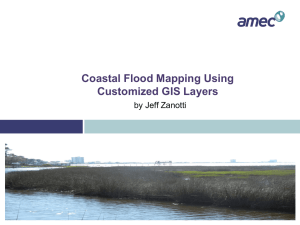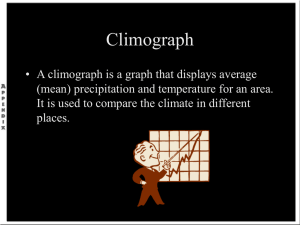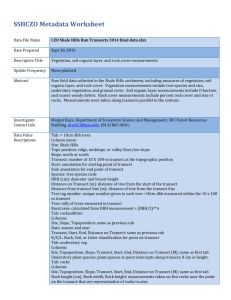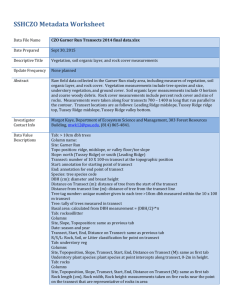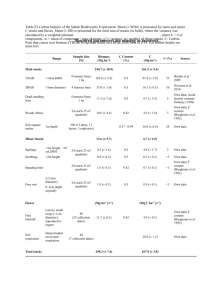Transect Vegetation Zone Investigation (high school)
advertisement
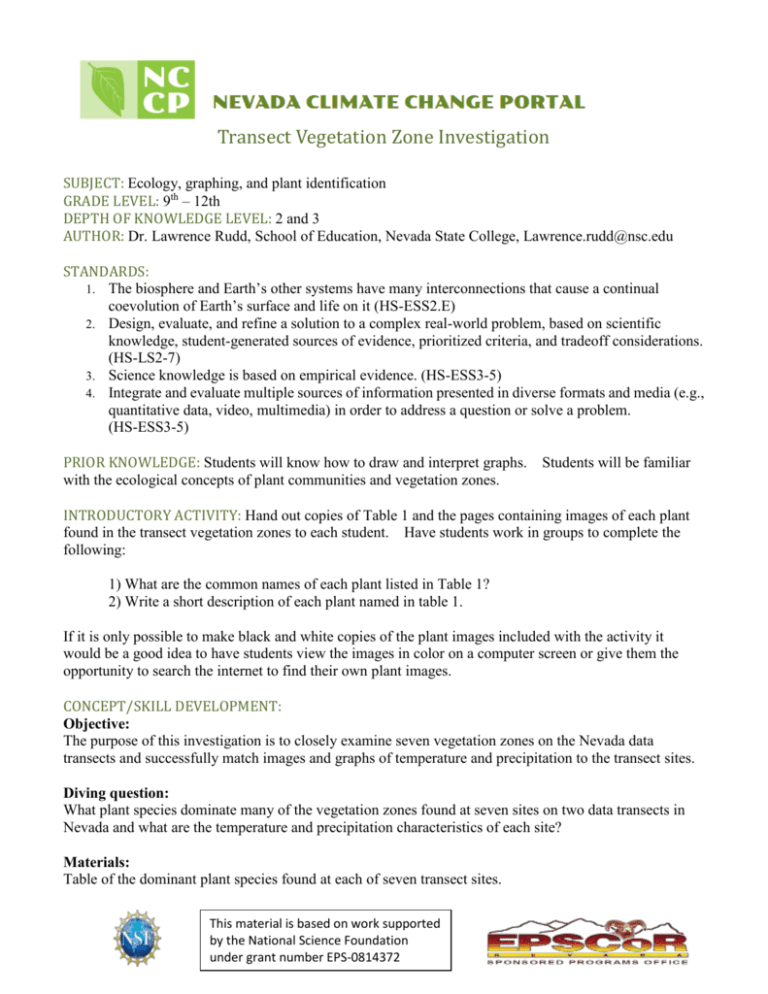
Transect Vegetation Zone Investigation SUBJECT: Ecology, graphing, and plant identification GRADE LEVEL: 9th – 12th DEPTH OF KNOWLEDGE LEVEL: 2 and 3 AUTHOR: Dr. Lawrence Rudd, School of Education, Nevada State College, Lawrence.rudd@nsc.edu STANDARDS: 1. The biosphere and Earth’s other systems have many interconnections that cause a continual coevolution of Earth’s surface and life on it (HS-ESS2.E) 2. Design, evaluate, and refine a solution to a complex real-world problem, based on scientific knowledge, student-generated sources of evidence, prioritized criteria, and tradeoff considerations. (HS-LS2-7) 3. Science knowledge is based on empirical evidence. (HS-ESS3-5) 4. Integrate and evaluate multiple sources of information presented in diverse formats and media (e.g., quantitative data, video, multimedia) in order to address a question or solve a problem. (HS-ESS3-5) PRIOR KNOWLEDGE: Students will know how to draw and interpret graphs. Students will be familiar with the ecological concepts of plant communities and vegetation zones. INTRODUCTORY ACTIVITY: Hand out copies of Table 1 and the pages containing images of each plant found in the transect vegetation zones to each student. Have students work in groups to complete the following: 1) What are the common names of each plant listed in Table 1? 2) Write a short description of each plant named in table 1. If it is only possible to make black and white copies of the plant images included with the activity it would be a good idea to have students view the images in color on a computer screen or give them the opportunity to search the internet to find their own plant images. CONCEPT/SKILL DEVELOPMENT: Objective: The purpose of this investigation is to closely examine seven vegetation zones on the Nevada data transects and successfully match images and graphs of temperature and precipitation to the transect sites. Diving question: What plant species dominate many of the vegetation zones found at seven sites on two data transects in Nevada and what are the temperature and precipitation characteristics of each site? Materials: Table of the dominant plant species found at each of seven transect sites. This material is based on work supported by the National Science Foundation under grant number EPS-0814372 Images of each of the seven transect sites Climographs (graphs showing Temperature and Precipitation vs. Month) of each transect site. Images of individual plants found at the transect sites. Important Terms: Dominant plant species Sheep Range (Nevada) Snake Range (Nevada) Vegetation zone Temperature and precipitation vs. month graphs (Climograph) Resources http://www.weather.com/encyclopedia/ Descriptions of a variety of storms and weather phenomena in an encyclopedic format. http://www.exploringweather.com/index.html A site that focuses on storms, as well as the process of weather forecasting. includes a useful glossary of weather terms. This site also http://sensor.nevada.edu/NCCP/Default.aspx The Nevada Climate Change Portal. This site explains the Nevada Climate Change project. http://daymet.ornl.gov/custom_home This site gives access to a model that provides weather data for North America from 1980 to 2011. Click on Daily Data for a Single Pixel in the left-hand column to get weather data for any location in North America. Investigation: While you are working on the introductory activity, visit the site: http://sensor.nevada.edu/NCCP/Climate%20Monitoring/Equipment.aspx to examine both the instrumentation at each transect site as well as the location of the data transects themselves. Examine the images of seven transect data sites. Match the transect sites in the table below to the site images by number. Once you have matched the transect images to the sites listed in the table below, examine the temperature precipitation graphs and match each graph to one of the sites on the table. Use any resources available to you, including the internet, to find both more information and images for the dominant plant species for each zone. A set of labeled plant images is provided for reference. This information will help you match the images and graphs of each zone to the transect zones on the table below. CLOSING ACTIVITY: Students should work in groups to complete this activity. the class at the end of the activity. This material is based on work supported by the National Science Foundation under grant number EPS-0814372 Have each group present their results to Transect Vegetation Zone Investigation Table 1. Site descriptions of locations along the two NevCAN transects. Transect (Mountain Range) Zone Snake Salt Desert Sarcobatus vermiculatus, Atriplex confertifolia 1560 (5120 ft.) Snake Sagebrush Artemisia tridentata tridentata, Sarcobatus vermiculatus 1790 (5870 ft.) Snake Pinyon-Juniper Pinus monophylla, Juniperus osteosperma 2200 (7220 ft.) Snake Subalpine Sheep Desert Shrub Larrea tridentata, Ambrosia dumosa 900 (2950 ft.) Sheep Blackbrush Yucca brevifolia, Atriplex canescens 1670 (5480 ft.) Sheep Montane Pinus ponderosa, Juniperus osteosperma 2320 (7610 ft.) Dominant Plant Species Pinus longaeva, Pinus flexilis This material is based on work supported by the National Science Foundation under grant number EPS-0814372 Altitude (m) 3355 (11,000 ft.) Site Image Climograph Site Images Taken at Each Transect Station Examine the vegetation shown in each of the images below. When you have identified the dominant plant species in an image, place the letter for that site image in the matching Site Image column in Table 1. Figure 1. Site Image A This material is based on work supported by the National Science Foundation under grant number EPS-0814372 Figure 2. Site Image B This material is based on work supported by the National Science Foundation under grant number EPS-0814372 Figure 3. Site Image C This material is based on work supported by the National Science Foundation under grant number EPS-0814372 Figure 4. Site Image D This material is based on work supported by the National Science Foundation under grant number EPS-0814372 Figure 5. Site Image E This material is based on work supported by the National Science Foundation under grant number EPS-0814372 Figure 6. Site Image F This material is based on work supported by the National Science Foundation under grant number EPS-0814372 Figure 7. Site Image G This material is based on work supported by the National Science Foundation under grant number EPS-0814372 Climographs Showing Temperature and Precipitation at Each Transect Site Examine the precipitation and temperature data shown in each of the graphs below. When you find a combination of precipitation and temperature that you feel describes one of the vegetation zones listed in Table 1, place the number for that climograph in the matching Climograph column in Table 1. Figure 8. Site 1 Climograph This material is based on work supported by the National Science Foundation under grant number EPS-0814372 Figure 9. Site 2 Climograph This material is based on work supported by the National Science Foundation under grant number EPS-0814372 Figure 10. Site 3 Climograph This material is based on work supported by the National Science Foundation under grant number EPS-0814372 Figure 11. Site 4 Climograph This material is based on work supported by the National Science Foundation under grant number EPS-0814372 Figure 12. Site 5 Climograph This material is based on work supported by the National Science Foundation under grant number EPS-0814372 Figure 13. Site 6 Climograph This material is based on work supported by the National Science Foundation under grant number EPS-0814372 Figure 14. Site 7 Climograph This material is based on work supported by the National Science Foundation under grant number EPS-0814372 Images of Plants Found in the Transect Vegetation Zones Figure 15. Greasewood (Sarcobatus vermiculatus) Figure 16. Shadscale (Atriplex confertifolia) This material is based on work supported by the National Science Foundation under grant number EPS-0814372 Figure 17. Sagebrush (Artemisia tridentata tridentata Figure 18. Pinon pine (Pinus monophylla) This material is based on work supported by the National Science Foundation under grant number EPS-0814372 Figure 19. Juniper ( Juniperus osteosperma) Figure 20. Bristlecone pine (Pinus longaeva) This material is based on work supported by the National Science Foundation under grant number EPS-0814372 Figure 21. Limber pine (pinus flexilis) Figure 22. Creosote bush (Larrea tridentata) This material is based on work supported by the National Science Foundation under grant number EPS-0814372 Figure 23. White bursage (Ambrosia dumosa) Figure 24. Joshua tree (Yucca brevifolia) This material is based on work supported by the National Science Foundation under grant number EPS-0814372 Figure 25. Four-wing saltbrush (Atriplex canescens) Figure 26. Ponderosa pine (Pinus ponderosa) This material is based on work supported by the National Science Foundation under grant number EPS-0814372
